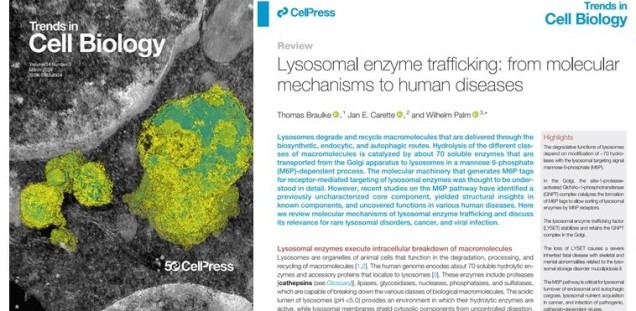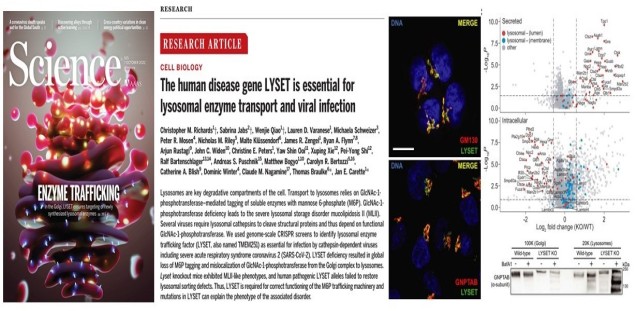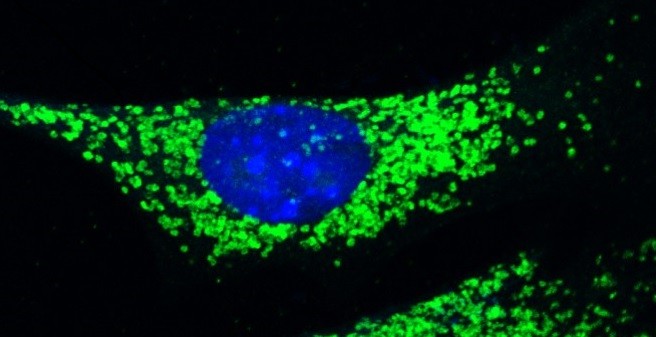
Leitung

- Forschungsgruppenleiter
- Forschung
- Team
- Publikationen
- Förderung
- NEWS
-
Forschung
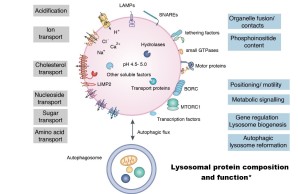
Lysosomen kontrollieren den Abbau, die Prozessierung und Recycling von Proteinen, Lipiden, Glykanen und Nukleinsäuren, die über biosynthetische, endo- oder phagozytotische Transportrouten und Autophagie zu den Organellen gelangen. An diesen Prozessen sind ca. 70 hydrolytische Enzyme, akzessorische Proteine und 250 Membranproteine, Transporter und Ionenkanäle beteiligt. Lysosomen können außerdem mit Autophagosomen fusionieren, um so intrazelluläre Nährstoffe zurückzugewinnen und Proteinaggregate, Bakterien oder beschädigte Mitochondrien und Lysosomen abzubauen.
In den letzten Jahren hat die Identifizierung neuer Proteine auf der zytosolischen Lysosomenoberfläche die Bandbreite der Funktionen, an denen Lysosomen beteiligt sind, wesentlich vergrößert. Dazu zählen die Fusion und die Ausbildung temporärer Kontakte mit anderen Organellen, die Positionierung und Bewegung der Lysosomen innerhalb der Zelle, die Detektion lysosomaler Abbauprodukte und die daraus resultierende Regulation von lysosomalen und Autophagiegenen.
Viele erbliche Gendefekte lysosomaler Enzyme und Membranproteine führen zu Fehlfunktionen der Lysosomen, in deren Folge es zur Akkumulation nicht abgebauter Substrate (lysosomales Speichermaterial) und zu Veränderungen der Größe, Ultrastruktur und der intrazellulären Positionierung der Lysosomen kommt.
In diesem Zusammenhang untersuchen wir
· den Einfluss von Mannose-6-Phosphat (MP6) Modifikationen lysosomaler Enzyme im Hinblick auf ihre Sortierung und Funktion,
- M6P-unabhängige Transportwege zu den Lysosomen und
· die transkriptionelle Regulation der Biogenese von Lysosomen.
Dabei benutzen wir modernste zellbiologische Methoden, bildgebende und biochemische Verfahren, einschließlich quantitativer Massenspektrometrie, um zelluläre Systeme, Organoide, und Mausmodelle lysosomaler Speichererkrankungen des Menschen zu analysieren.
Unsere Forschung führt zu einem besseren Verständnis, 1. wie Lysosomen die Homöostase in der Zelle und im gesamten Organismus aufrecht erhalten, 2. welche Pathomechanismen lysosomalen Erkrankungen wie Mucolipidose Typ II und III oder Neuronalen Ceroid Lipofuszinosen zugrunde liegen, und 3. welche neuen therapeutischen Strategien sich daraus entwickeln lassen.
*Abbildung verändert aus Ballabio & Bonifacino (Nat Rev Mol Cell Biol. 2020; 21:101-118)
-
-
Team
 Prof. Dr. rer. nat.Thomas Braulke
Prof. Dr. rer. nat.Thomas Braulke- Forschungsgruppenleiter
TelefonE-Mail Dr. rer. nat.Dorthe Labonté
Dr. rer. nat.Dorthe Labonté- Wissenschaftliche Mitarbeiterin
TelefonE-Mail Emanuela CapriottiM. Sc.
Emanuela CapriottiM. Sc.- Wissenschaftliche Mitarbeiterin
Standort
Campus Forschung I - N27 , 1. EtageEhemalige Arbeitsgruppenmitglieder
Gianmarco Del Gallo, M.Sc.
Anastasia Laudicina, PhD
Dr. rer. nat. Malte Klüssendorf
Jane Rehberg (TA)
Dr. med. Svenja Krambeck
Dr. med. Khandsuren Ariunbat
Johannes Brand (TA)
Dr. rer. nat. Carolin Schmidtke
Dr. rer. nat. Jessica Schmiesing
PD Dr. rer. nat. Stephan Storch
Dr. rer. nat. Tatyana Danyukova
Prof. Dr. rer. nat. Sandra Pohl
Dr. med. Ann-Cathrin Dörfler
Dr. rer. nat. Nina Westphal
Cinta Diez-Ardanuy, PhD
Giorgia Di Lorenzo, PhD
Dr. med. Benjamin Lohmöller
Dr. med. Elisabeth Schöne
Dr. rer. nat. Georgia Makrypidi-Fraune
Sneha Nemani, M. Sc.
Dr. rer. nat. Laura Brandenstein
Dr. rer. nat. Raffaella De Pace
Dr. rer. nat. Sandra Markmann
Dr. rer. nat. Sarah Klünder
Prof. Dr. med Takanobu Otomo
Dr. rer. nat. Mine Franke
Dr. rer. nat. Katrin Kollmann
Dr. med. Kathrin Karkmann
Dr. rer. nat. Pieter Steenhuis
Dr. rer. nat. Melanie Thelen
Dr. rer. nat. Katrin Marschner
Dr. med. Bastian Thies
Dr. rer. nat Marisa Encarnação
Dr. rer. nat. Annika Kurze
Dr. rer. nat. Giovanna Galliciotti
Cand. med. Anna-Katharina Röchert
Dr. rer. nat. Anne-Hélène Lebrun
Inke Stange (TA)
Dr. med. Nicole Muschol
Dr. rer. nat. Britta Keyser
Dr. med. Brit Hofmann
Manuel-Álvaro Berbis-Moreno
Monica Castrichini, PhD
Dipl-Biol. Guillermo F. Jofre
Dr. rer. nat. Arne Quitsch
Dr. rer. nat. Sabrina Jabs
Dr. med. Franziska Stellmer
Dr. rer. nat. Karin Fritsch
Dr. med. dent. Silvia Bier
Dr. med. dent. Marta Krzoska
Dr. rer. nat. Bettina Koch
Dr. rer. nat. Bernd Kübler
Dr. rer. nat. Sandra Oesterreicher
Dr. rer. nat. Nicola Ott
Dr. rer. nat. Stephan Tiede
Dr. rer. nat. Claudia Heine
Dr. med. Bettina Bertram
Dr. med. Victoria Schebek-Fürstenberg
-
Publikationen
2024
[119] GOLPH3 and GOLPH3L maintain Golgi localization of LYSET and a functional mannose 6-phosphate transport pathway. Brauer BK, Chen Z, Beirow F, Li J, Meisinger D, Capriotti E, Schweizer M, Wagner L, Wienberg J, Hobohm L, Blume L, Qiao W, Narimatsu Y, Carette JE, Clausen H, Winter D, Braulke T, Jabs S, Voss M. (2024) EMBO J doi: 10.1038/s44318-024-00305-z. Abstract
[118] Lysosomal enzyme trafficking: from molecular mechanisms to human diseases. Braulke T, Carette JE, Palm W (2024) Trends Cell Biol 34:198-210. Abstract
2022
[117] The human disease gene LYSET is essential for lysosomal enzyme transport and viral infection. Richards CM, Jabs S, Qiao W, Varanese LD, Schweizer M, Mosen PR, Riley NM, Klüssendorf M, Zengel JR, Flynn RA, Rustagi A, Widen JC, Peters CE, Ooi YS, Xie X, Shi PY, Bartenschlager R, Puschnik AS, Bogyo M, Bertozzi CR, Blish CA, Winter D, Nagamine CM, Braulke T, Carette JE (2022) Sciene eabn5648. doi: 10.1126/science.abn5648 Abstract
[116] Early enzyme replacement therapy prevents dental and craniofacial abnormalities in a mouse model of mucopolysaccharidosis type VI. Nagpal R, Georgi G, Knauth S, Schmid-Herrmann C, Muschol N, Braulke T, Kahl-Nieke B, Amling M, Schinke T, Koehne T, Petersen J (2022) Front Physiol 13:998039. Abstract
[115] P-Type Lectins. Dahms N, Braulke T, Varki A. (2022) Book Chapter in Essentials of Glycobiology [Internet]. 4th edition. Cold Spring Harbor (NY): Cold Spring Harbor Laboratory Press; Chapter 33. Abstract
2021
[114] Repurposing of tamoxifen ameliorates CLN3 and CLN7 disease phenotype. Fabuel I, Wanderlingh LG, Garcia-Macia M, Monfregola J, Esposito A, Napolitano G, Guevara-Ferrer M, Scotto Rosato A, Krogsaeter EK, Paquet D, Grimm CM, Montefusco S, Braulke T, Storch S, Mole SE, De Matteis MA, Ballabio A, Sampaio JL, McKay T, Johannes L, Bolaños JP, Medina DL (2021) EMBO Mol Med doi: 10.15252/emmm.202013742 Abstract
[113] Pathogenic variants in GNPTAB and GNPTG encoding distinct subunits of GlcNAc-1-phosphotransferase differentially impact bone resorption in patients with mucolipidosis type II and III. Di Lorenzo G, Westermann LM, Yorgan TA, Stürznickel J, Ludwig NF, Ammer LS, Baranowsky A, Ahmadi S, Pourbarkhordariesfandabadi E, Breyer SR, Board TN, Foster A, Mercer J, Tylee K, Velho RV, Schweizer M, Renné T, Braulke T, Randon DN, Sperb-Ludwig F, de Camargo Pinto LL, Moreno CA, Cavalcanti DP, Amling M, Kutsche K, Winter D, Muschol NM, Schwartz IVD, Rolvien T, Danyukova T, Schinke T, Pohl S (2021) Genet Med doi: 10.1038/s41436-021-01285-9 Abstract
2020
[112] Distinct Modes of Balancing Glomerular Cell Proteostasis in Mucolipidosis Type II and III Prevent Proteinuria. Sachs W, Sachs M, Krüger E, Zielinski S, Kretz O, Huber TB, Baranowsky A, Westermann LM, Voltolini Velho R, Ludwig NF, Yorgan TA, Di Lorenzo G, Kollmann K, Braulke T, Schwartz IV, Schinke T, Danyukova T, Pohl S, Meyer-Schwesinger C (2020) J Am Soc Nephrol 31:1796-814 Abstract
2019
[111] Lysosomal proteome analysis reveals that CLN3-defective cells have multiple enzyme deficiencies associated with changes in intracellular trafficking. Schmidtke C, Tiede S, Thelen M, Käkelä R, Jabs S, Makrypidi G, Sylvester M, Schweizer M, Braren I, Brocke-Ahmadinejad N, Cotman SL, Schulz A, Gieselmann V, Braulke T (2019) J Biol Chem 294:9592-604 Abstract
[110] Influenza binds phosphorylated glycans from human lung. Byrd-Leotis L, Jia N, Dutta S, Trost JF, Gao C, Cummings SF, Braulke T, Müller-Loennies S, Heimburg-Molinaro J, Steinhauer DA, Cummings RD (2019) Sci Adv 5:eaav2554 Abstract
2018
[109] The lysosomal protein arylsulfatase B is a key enzyme involved in skeletal turnover. Pohl S, Angermann A, Jeschke A, Hendrickx G, Yorgan TA, Makrypidi-Fraune G, Steigert A, Kühn SC, Rolvien T, Schweizer M, Köhne T, Neven M, Winter O, Velho RV, Albers J, Streichert T, Pestka JM, Baldauf C, Breyer S, Stuecker R, Muschol N, Cox TM, Saftig P, Paganini C, Rossi A, Amling M, Braulke T, Schinke T (2018) J Bone Miner Res 33:2186-201 Abstract
[108] Disease-linked glutarylation impairs function and interactions of mitochondrial
proteins and contributes to mitochondrial heterogeneity. Schmiesing J, Storch S, Dörfler AC, Schweizer M, Makrypidi-Fraune G, Thelen M, Sylvester M, Gieselmann V, Meyer-Schwesinger C, Koch-Nolte F, Tidow H, Mühlhausen C, Waheed A, Sly WS, Braulke T (2018) Cell Rep 24:2946-56 Abstract[107] Lysosomal proteome and secretome analysis identifies missorted enzymes and their non-degraded substrates in mucolipidosis III mouse cells. Di Lorenzo G, Voltolini Velho R, Winter D, Thelen M, Ahmadi S, Schweizer M, De Pace R, Cornils K, Yorgan TA, Grüb S, Hermans-Borgmeyer I, Schinke T, Müller-Loennies S, Braulke T, Pohl S (2018) Mol Cell Proteomics 17:1612-26 Abstract
2017
[106] GNPTAB missense mutations cause loss of GlcNAc-1-phosphotransferase activity in mucolipidosis type II through distinct mechanisms. Ludwig NF, Velho RV, Sperb-Ludwig F, Acosta AX, Ribeiro EM, Kim CA, Gandelman Horovitz DD, Boy R, Rodovalho-Doriqui MJ, Lourenço CM, Santos ES, Braulke T, Pohl S, Schwartz IVD (2017) Int J Biochem Cell Biol 92:90-4 Abstract
[105] Site-1 protease and lysosomal homeostasis. Velho RV, De Pace R, Klünder S, Di Lorenzo G, Schweizer M, Braulke T, Pohl S (2017) Biochim Biophys Acta Mol Cell Res 1864:2162-8 Abstract
[104] SILAC-Based Comparative Proteomic Analysis of Lysosomes from Mammalian Cells Using LC-MS/MS. Thelen M, Winter D, Braulke T, Gieselmann V (2017) Methods Mol Biol 1594:1-18 Abstract
[103] Quantitative proteome analysis of mouse liver lysosomes provides evidence for mannose 6-phosphate-independent targeting mechanisms of acid hydrolases in mucolipidosis II. Markmann S, Krambeck S, Hughes CJ, Mirzaian M, Aerts JM, Saftig P, Schweizer M, Vissers JC, Braulke T, Damme M (2017) Mol Cell Proteomics 16:438-50 Abstract
[102] Disease-causing mutations affecting surface residues of mitochondrial glutaryl-CoA dehydrogenase impair stability, heteromeric complex formation and mitochondria architecture. Schmiesing J, Lohmöller B, Schweizer M, Tidow H, Gersting SW, Muntau AC, Braulke T, Mühlhausen C (2017) Hum Mol Genet 26:538-51 Abstract
2016
[101] Identification of the interaction domains between α- and γ-subunits of GlcNAc-1-phosphotransferase. Velho RV, De Pace R, Tidow H, Braulke T, Pohl S (2016) FEBS Lett 590:4287-95 Abstract
[100] Mannose 6-phosphate-dependent targeting of lysosomal enzymes is required for normal craniofacial and dental development. Koehne T, Markmann S, Schweizer M, Muschol N, Friedrich RE, Hagel C, Glatzel M, Kahl-Nieke B, Amling M, Schinke T, Braulke T (2016) Biochim Biophys Acta 1862:1570-80 Abstract
[99] Single-chain antibody-fragment M6P-1 possesses a mannose 6-phosphate monosaccharide-specific binding pocket that distinguishes N-glycan phosphorylation in a branch-specific manner. Blackler RJ, Evans DW, Smith DF, Cummings RD, Brooks CL, Braulke T, Liu X, Evans SV, Müller-Loennies S (2016) Glycobiology 26:181-92 Abstract
2015
[98] In Vivo Evidence for Lysosome Depletion and Impaired Autophagic Clearance in Hereditary Spastic Paraplegia Type SPG11. Varga RE, Khundadze M, Damme M, Nietzsche S, Hoffmann B, Stauber T, Koch N, Hennings JC, Franzka P, Huebner AK, Kessels MM, Biskup C, Jentsch TJ, Qualmann B, Braulke T, Kurth I, Beetz C, Hübner CA (2015) PLoS Genet 11:e1005454 Abstract
[97] Mannose 6 phosphorylation of lysosomal enzymes controls B cell function. Otomo T, Schweizer M, Kollmann K, Schumacher V, Muschol N, Tolosa E, Mittrücker HW, Braulke T (2015) J Cell Biol 208:171-80 Abstract
[96] Lrp1/LDL Receptor Play Critical Roles in Mannose 6-Phosphate-Independent Lysosomal Enzyme Targeting. Markmann S, Thelen M, Cornils K, Schweizer M, Brocke-Ahmadinejad N, Willnow T, Heeren J, Gieselmann V, Braulke T, Kollmann K (2015) Traffic 16:743-59 Abstract
[95] Analyses of disease-related GNPTAB mutations define a novel GlcNAc1-phosphotransferase interaction domain and an alternative site-1 protease cleavage site. Velho RV, De Pace R, Klünder S, Sperb-Ludwig F, Lourenço CM, Schwartz IV, Braulke T, Pohl S (2015) Hum Mol Genet 24:3497-505 Abstract
[94] Sustained Neural Stem Cell-Based Intraocular Delivery of CNTF Attenuates Photoreceptor Loss in the nclf Mouse Model of Neuronal Ceroid Lipofuscinosis. Jankowiak W, Kruszewski K, Flachsbarth K, Skevas C, Richard G, Rüther K, Braulke T, Bartsch U (2015) PLoS One 10:e0127204 Abstract
[93] Lysoplex: An efficient toolkit to detect DNA sequence variations in the autophagy-lysosomal pathway. Di Fruscio G, Schulz A, De Cegli R, Savarese M, Mutarelli M, Parenti G, Banfi S, Braulke T, Nigro V, Ballabio A (2015) Autophagy 11:928-38 Abstract
[92] Site-1 protease-activated formation of lysosomal targeting motifs is independent of the lipogenic transcription control. Klünder S, Heeren J, Markmann S, Santer R, Braulke T, Pohl S (2015) J Lipid Res 56:1625-32 Abstract
[91] Mannose 6-phosphate-independent Lysosomal Sorting of LIMP-2. Blanz J, Zunke F, Markmann S, Damme M, Braulke T, Saftig P, Schwake M (2015) Traffic 16:1127-36 Abstract
[90] Subunit interactions of the disease-related hexameric GlcNAc-1-phosphotransferase complex. De Pace R, Velho RV, Encarnação M, Marschner K, Braulke T, Pohl S (2015) Hum Mol Genet 24:6826-3 Abstract
[89] Impaired bone remodeling and its correction by combination therapy in a mouse model of mucopolysaccharidosis-I. Kuehn SC, Koehne T, Cornils K, Markmann S, Riedel C, Pestka JM, Schweizer M, Baldauf C, Yorgan TA, Krause M, Keller J, Neven M, Breyer S, Stuecker R, Muschol N, Busse B, Braulke T, Fehse B, Amling M, Schinke T (2015) Hum Mol Genet 24:7075-86 Abstract
[88] Biosynthesis, targeting, and processing of lysosomal proteins: pulse-chase labeling and immune precipitation. Pohl S, Hasilik A (2015)
Methods Cell Biol
126:63-83 Abstract2014
[87] Evaluation of butyrate-induced production of a mannose-6-phosphorylated therapeutic enzyme using parallel bioreactors. Madhavarao CN, Agarabi CD, Wong L, Müller-Loennies S, Braulke T, Khan M, Anderson H, Johnson GR (2014) Biotechnol Appl Biochem 61:184-92 Abstract
[86] Molecular characterization of arylsulfatase G: expression, processing, glycosylation, transport, and activity. Kowalewski B, Lübke T, Kollmann K, Braulke T, Reinheckel T, Dierks T, Damme M (2014) J Biol Chem 289:27992-8005 Abstract
[85] Lysine glutarylation is a protein posttranslational modification regulated by SIRT5. Tan M, Peng C, Anderson KA, Chhoy P, Xie Z, Dai L, Park J, Chen Y, Huang H, Zhang Y, Ro J, Wagner GR, Green MF, Madsen AS, Schmiesing J, Peterson BS, Xu G, Ilkayeva OR, Muehlbauer MJ, Braulke T, Mühlhausen C, Backos DS, Olsen CA, McGuire PJ, Pletcher SD, Lombard DB, Hirschey MD, Zhao Y (2014) Cell Metab 19:605-17 Abstract
[84] Mucolipidosis II-Related Mutations Inhibit the Exit from the Endoplasmic Reticulum and Proteolytic Cleavage of GlcNAc-1-Phosphotransferase Precursor Protein (GNPTAB). De Pace R, Coutinho MF, Koch-Nolte F, Haag F, Prata MJ, Alves S, Braulke T, Pohl S (2014) Hum Mutat 35:368-76 Abstract
[83] Interaction of Glutaric Aciduria Type 1-Related glutaryl-CoA Dehydrogenase with Mitochondrial Matrix Proteins. Schmiesing J, Schlüter H, Ullrich K, Braulke T, Mühlhausen C (2014) PLoS One 9:e87715 Abstract
2013
[82] A hereditary spastic paraplegia mouse model supports a role of ZFYVE26/SPASTIZIN for the endolysosomal system. Khundadze M, Kollmann K, Koch N, Biskup C, Nietzsche S, Zimmer G, Hennings JC, Huebner AK, Symmank J, Jahic A, Ilina EI, Karle K, Schöls L, Kessels M, Braulke T, Qualmann B, Kurth I, Beetz C, Hübner CA (2013) PLoS Genet 9:e1003988 Abstract
[81] Decreased bone formation and increased osteoclastogenesis cause bone loss in mucolipidosis II. Kollmann K, Pestka JM, Kühn SC, Schöne E, Schweizer M, Karkmann K, Otomo T, Catala-Lehnen P, Failla AV, Marshall RP, Krause M, Santer R, Amling M, Braulke T, Schinke T (2013) EMBO Mol Med 5:1871-86 Abstract
[80] Apoptotic Photoreceptor Loss and Altered Expression of Lysosomal Proteins in the nclf Mouse Model of Neuronal Ceroid Lipofuscinosis. Bartsch U, Galliciotti G, Jofre GF, Jankowiak W, Hagel C, Braulke T (2013) Invest Ophthalmol Vis Sci 54:6952-9 Abstract
[79] Ultrastructural analysis of neuronal and non-neuronal lysosomal storage in mucolipidosis type II knock-in mice. Schweizer M, Markmann S, Braulke T, Kollmann K (2013) Ultrastruct Pathol 37:366-72 Abstract
[78] Acute renal proximal tubule alterations during induced metabolic crises in a mouse model of glutaric aciduria type 1. Thies B, Meyer-Schwesinger C, Lamp J, Schweizer M, Koeller DM, Ullrich K, Braulke T, Mühlhausen C (2013) Biochim Biophys Acta 1832:1463-72 Abstract
[77] Cell biology and function of neuronal ceroid lipofuscinosis-related proteins. Kollmann K, Uusi-Rauva K, Scifo E, Tyynelä J, Jalanko A, Braulke T (2013) Biochim Biophys Acta 1832:1866-81 Abstract
[76] Mass spectrometric analysis of neutral and anionic N-glycans from a Dictyostelium discoideum model for human congenital disorder of glycosylation CDG IL. Hykollari A, Balog CI, Rendic D, Braulke T, Wilson IB, Paschinger K (2013) J Proteome Res 12:1173-87 Abstract
[75] Transport of the GlcNAc-1-phosphotransferase α/β-subunit precursor protein to the Golgi apparatus requires a combinatorial sorting motif. Franke M, Braulke T, Storch S (2013) J Biol Chem 288:1238-49 Abstract
2012
[74] Lysosomal dysfunction causes neurodegeneration in mucolipidosis II ‘knock-in’ mice. Kollmann K, Damme M, Markmann S, Morelle W, Schweizer M, Hermans-Borgmeyer I, Röchert AK, Pohl S, Lübke T, Michalski JC, Käkelä R. Walkley SU, Braulke T (2012) Brain 135:2661-75 Abstract
[73] The 5-phosphatase OCRL mediates retrograde transport of the mannose 6-phosphate receptor by regulating a Rac1-cofilin signalling module. van Rahden VA, Brand K, Najm J, Heeren J, Pfeffer SR, Braulke T, Kutsche K (2012) Brain 135:2661-75 Abstract
[72] Disruption of the Autophagy-Lysosome Pathway Is Involved in Neuropathology of the nclf Mouse Model of Neuronal Ceroid Lipofuscinosis. Thelen M, Damme M, Schweizer M, Hagel C, Wong AM, Cooper JD, Braulke T, Galliciotti G (2012) Plos One 7:e35493 Abstract
[71] A novel mannose 6-phosphate specific antibody fragment for diagnosis of Mucolipidosis type II and III. (Book chapter) Pohl S, Braulke T, Müller-Loennies S (2012) In: Anticarbohydrate antibodies - From molecular basis to clinical application (Eds: P. Kosma, S. Müller-Loennies), Springer-Verlag, Wien, 307-327
[70] Multiple Enzyme Deficiencies: Defects in transport: Mucolipidosis II alpha/beta; mucolipidosis III alpha/beta and mucolipidosis III gamma. (Book chapter) Raas-Rothschild A, Pohl S, Braulke T (2012) In: Lysosomal Storage Diseases: A Practical Guide (Eds. A. B. Mehta, B. Winchester), WILEY-BLACKWELL, Oxford
[69] Mannose 6-dephosphorylation of lysosomal proteins mediated by acid phosphatases Acp2 and Acp5. Makrypidi G, Damme M, Müller-Loennies S, Trusch M, Schmidt B, Schlüter H, Heeren J, Lübke T, Saftig P, Braulke T (2012) Mol Cell Biol 32:774-82 Abstract
[68] High expression of disease-related Cln6 in the cerebral cortex, purkinje cells, dentate gyrus, and hippocampal ca1 neurons. Thelen M, Fehr S, Schweizer M, Braulke T, Galliciotti G (2012) J Neurosci Res 90:568-74 Abstract
2011
[67] A key enzyme in the biogenesis of lysosomes is a protease that regulates cholesterol metabolism. Marschner K, Kollmann K, Schweizer M, Braulke T, Pohl S (2011) Science 333:87-90 Abstract
[66] N-glycans and glycosylphosphatidylinositol-anchor act on polarized sorting of mouse PrP(C) in Madin-Darby canine kidney cells. Puig B, Altmeppen HC, Thurm D, Geissen M, Conrad C, Braulke T, Glatzel M (2011) PLoS One 6:e24624 Abstract
[65] Analysis of Potential Biomarkers and Modifier Genes Affecting the Clinical Course of CLN3 Disease. Lebrun AH, Moll-Khosrawi P, Pohl S, Makrypidi G, Storch S, Kilian D, Streichert T, Otto B, Mole SE, Ullrich K, Cotman S, Kohlschütter A, Braulke T, Schulz A (2011) ) Mol Med 17:1253-61 Abstract
[64] Glutaric aciduria type 1 metabolites impair the succinate transport from astrocytic to neuronal cells. Lamp J, Keyser B, Koeller DM, Ullrich K, Braulke T, Mühlhausen C (2011) J Biol Chem 286:17777-84 Abstract
[63] Residual activity and proteasomal degradation of p.Ser298Pro sulfamidase identified in patients with a mild clinical phenotype of Sanfilippo A syndrome. Muschol N, Pohl S, Meyer A, Gal A, Ullrich K, Braulke T (2011) Am J Med Genet A 155:1634-9 Abstract
[62] Post-translational modifications of the gamma-subunit affect intracellular trafficking and complex assembly of GlcNAc-1-phosphotransferase. Encarnação M, Kollmann K, Trusch M, Braulke T, Pohl S (2011) J Biol Chem 286:5311-8 Abstract
2010
[61] A novel single-chain antibody fragment for detection of mannose 6-phosphate-containing proteins. Application in mucolipidosis type II patinets and mice. Müller-Loennies S, Galliciotti G, Kollmann K, Glatzel M, Braulke T (2010) Am J Pathol 177:240-7 Abstract
[60] Proteolytic processing of the gamma-subunit is associated with the failure to form GlcNAc-1-phosphotransferase complexes and mannose 6-phosphate residues on lysosomal enzymes in human macrophages. Pohl S, Tiede S, Marschner K, Encarnação M, Castrichini M, Kollmann K, Muschol N, Ullrich K, Müller-Loennie S, Braulke T (2010) J Biol Chem 285:23936-44 Abstract
[59] Mannose phosphorylation in health and disease. (Review) Kollmann K, Pohl S, Marschner K, Encarnação M, Sakwa I, Tiede S, Poorthuis BJ, Lübke T, Müller-Loennies S, Storch S, Braulke T (2010) Eur J Cell BIol 89:117-23 Abstract
[58] Site specific analysis of N-linked oligosaccharides of recombinant lysosomal arylsulfatase A produced in different cell lines. Schröder S, Matthes F, Hyden P, Andersson C, Fogh J, Müller-Loennies S, Braulke T, Gieselmann V, Matzner U (2010) Glycobiology 20:248-59 Abstract
[57] Loss of N-acetylglucosamine-1-phosphotransferase gamma-subunit due to intronic mutation in GNPTG causes mucolipidosis type III gamma: Implications for molecular and cellular diagnostics. Pohl S, Encarnacão M, Castrichini M, Müller-Loennies S, Muschol N, Braulke T (2010) Am J Med Genet A 152:124-32 Abstract
[56] Pathogenic mutations cause rapid degradation of lysosomal storage disease-related membrane protein CLN6. Kurze AK, Galliciotti G, Heine C, Mole SE, Quitsch A, Braulke T (2010) Hum Mutat 31:E1163-74 Abstract
[55] Glycostructures in biological systems - synthesis and function. (Review) Thiem J, Braulke T (2010) Eur J Cell Biol 89:1 Abstract
[54] Protein kinase a dependent phosphorylation of apical membrane antigen 1 plays an important role in erythrocyte invasion by the malaria parasite. Leykauf K, Treeck M, Gilson PR, Nebl T, Braulke T, Cowman AF, Gilberger TW, Crabb BS (2010) PLoS Pathog 6:e1000941 Abstract
2009
[53] Compensatory expression of human N-acetylglucosaminyl-1 phosphotransferase subunits in mucolipidosis type III gamma. Pohl S, Tiede S, Castrichini M, Cantz M, Gieselmann V, Braulke T (2009) Biochim Biophys Acta 1792:221-5 Abstract
[52] Glycosylation- and phosphorylation-dependent intracellular transport of lysosomal hydrolases. (Review) Pohl S, Marschner K, Storch S, Braulke T (2009) Biol Chem 390:521-7 Abstract
[51] Retention of lysosomal protein CLN5 in the endoplasmic reticulum causes neuronal ceroid lipofuscinosis in Asian sibship. Lebrun AH, Storch S, Rüschendorf F, Schmiedt ML, Kyttälä A, Mole SE, Kitzmüller C, Saar K, Mewasingh LD, Boda V, Kohlschütter A, Ullrich K, Braulke T, Schulz A (2009) Hum Mutat 30:E651-61 Abstract
[50] Lysosomes. (Review) Gieselmann V, Braulke T (2009) Biochim Biophys Acta 1793:603-4 Abstract
[49] Mannose 6-phosphate receptor-dependent endocytosis of lysosomal enzymes is increased in sulfatide-storing kidney cells. Klein D, Yaghootfam A, Matzner U, Koch B, Braulke T, Gieselmann V (2009) Biol Chem 390:41-8 Abstract
[48] Sorting of lysosomal proteins. (Review) Braulke T, Bonifacino JS (2009) Biochim Biophys Acta 1793:605-14 Abstract
[47] Neuronal ceroid lipofuscinoses. (Review) Jalanko A, Braulke T (2009) Biochim Biophys Acta 1793:697-709 Abstract
[46] Identification and molecular characterization of six novel mutations in the UDP-N-acetylglucosamine-1-phosphotransferase gamma subunit (GNPTG) gene in patients with mucolipidosis III gamma. Persichetti E, Chuzhanova NA, Dardis A, Tappino B, Pohl S, Thomas NS, Rosano C, Balducci C, Paciotti S, Dominissini S, Montalvo AL, Sibilio M, Parini R, Rigoldi M, Di Rocco M, Parenti G, Orlacchio A, Bembi B, Cooper DN, Filocamo M, Beccari T (2009) Hum Mutat 30:978-84 Abstract
2008
[45] Molecular order in mucolipidosis II and III nomenclature. Cathey SS, Kudo M, Tiede S, Raas-Rothschild A, Braulke T, Beck M, Taylor HA, Canfield WM, Leroy JG, Neufeld EF, McKusick VA (2008) Am J Med Genet A 146:512-3 Abstract
[44] Transport and distribution of 3-hydroxyglutaric acid before and during induced encephalopathic crises in a mouse model of glutaric aciduria type 1. Keyser B, Glatzel M, Stellmer F, Kortmann B, Lukacs Z, Kölker S, Sauer SW, Muschol N, Herdering W, Thiem J, Goodman SI, Koeller DM, Ullrich K, Braulke T, Mühlhausen C (2008) Biochem Biophys Acta 1782:385-90 Abstract
[43] Organic anion transporters OAT1 and OAT4 mediate the high affinity transport of glutarate derivatives accumulating in patients with glutaric acidurias. Hagos Y, Krick W, Braulke T, Mühlhausen C, Burckhardt G, Burckhardt BC (2008) Pflugers Arch 457:223-31 Abstract
[42] Membrane translocation of glutaric acid and its derivatives. Mühlhausen C, Burckhardt BC, Hagos Y, Burckhardt G, Keyser B, Lukacs Z, Ullrich K, Braulke T (2008) J Inherit Metab Dis 31:188-193 Abstract
[41] The mutation p.Ser298Pro in the sulphamidase gene (SGSH) is associated with a slowly progressive clinical phenotype in mucopolysaccharidosis type IIIA (Sanfilippo A syndrome). Meyer A, Kossow K, Gal A, Steglich C, Mühlhausen C, Ullrich K, Braulke T, Muschol N Meyer A, Kossow K, Gal A, Steglich C, Mühlhausen C, Ullrich K, Braulke T, Muschol (2008) Hum Mut 29:770 Abstract
[40] Molecular analysis of the GlcNac-1-phosphotransferase. (Review) Braulke T, Pohl S, Storch S (2008) J Inherit Metab Dis 31:253-7 Abstract
[39] Accumulation of bis(monoacylglycero)phosphate and gangliosides in mouse models of neuronal ceroid lipofuscinosis. Jabs S, Quitsch A, Käkelä R, Koch B, Tyynelä J, Brade H, Glatzel M, Walkley S, Saftig P, Vanier MT, Braulke T (2008) J Neurochem 106:1414-25 Abstract
[38] Disease-causing missense mutations affect enzymatic activity, stability and oligomerization of glutaryl-CoA dehydrogenase (GCDH). Keyser B, Mühlhausen C, Dickmanns A, Christensen E, Muschol N, Ullrich K, Braulke T (2008) Hum Mol Genet 17:3854-63 Abstract
[37] Multiple post-translational modifications of mouse insulin-like growth factor binding protein-6 expressed in epithelial Madin-Darby canine kidney cells. Shalamanova L, Kübler B, Storch S, Scharf JG, Braulke T (2008) Mol Cell Endocrinol 295:18-23 Abstract
2007
[36] Topology and endoplasmic reticulum retention signals of the lysosomal storage disease-related membrane protein CLN6. Heine C, Quitsch A, Storch S, Martin Y, Lonka L, Lehesjoki AE, Mole S, Braulke T (2007) Mol Membr Biol 24:74-87 Abstract
[35] C-terminal prenylation of the CLN3 membrane glycoprotein is required for efficient endosomal sorting to lysosomes. Storch S, Pohl S, Quitsch A, Falley K, Braulke T (2007) Traffic 8:431-44 Abstract
[34] 3-Hydroxyglutaric acid is transported via the sodium-dependent dicarboxylate transporter NaDC-3. Stellmer F, Keyser B, Burckhardt BC, Koepsell H, Streichert S, Glatzel M, Jabs S, Thiem J, Herdering W, Koeller DM, Goodman SI, Lukacs Z, Ullrich K, Burckhardt G, Braulke T, Mühlhausen C (2007) J Mol Med 85:763-70 Abstract
[33] Alteration of the insulin-like growth factor axis during in vitro differentiation of the human osteosarcoma cell line HOS 58. Viereck V, Siggelkow H, Pannem R, Braulke T, Scharf JG, Kübler B (2007) J Cell Biochem 102:28-40 Abstract
[32] Scoring evaluation of the natural course of mucopolysaccharidosis type IIIA (Sanfilippo Syndorme type A). Meyer A, Kossow K, Gal A, Mühlhausen C, Ullrich K, Braulke T, Muschol N (2007) Pediatrics 120:1255-61 Abstract
[31] Increased expression of lysosomal acid phosphatase (LAP/Acp2) in CLN3-defective cells and mouse brain tissue. Pohl S, Mitchison HM, Kohlschütter A, van Diggelen, O, Braulke T, Storch S (2007) J Neurochem 103:2177-88 Abstract
2006
[30] Endothelial effects of 3-hydroxyglutaric acid: implications for glutaric aciduria type I. Mühlhausen C, Ott N, Chalajour F, Tilki D, Freudenberg F, Ullrich K, Braulke T, Ergün S (2006) Pediatr Res 59:196-202 Abstract
[29] In vitro sulfation of N-acetyllactosaminide by soluble recombinant human beta-Gal-3'- sulfotransferase. Greimel P, Jabs S, Storch S, Cherif S, Honke K, Braulke T, Thiem J (2006) Carbohydr Res 341:918-24 Abstract
[28] Missense Mutation in the N-acetylglucosamine-1-phosphotransferase gene (GNPTA) in a patient with mucolipidosis II induces changes in the size and cellular distribution of GNPTG. Tiede S, Cantz M, Spranger J, Braulke T (2006) Hum Mutat 27:830-6 Abstract
[27] Functional Biology of the Neuronal Ceroid Lipofuscinoses (NCL) proteins. (Review) Kyttälä A, Lahtinen U, Braulke T, Hofmann SL (2006) Biochim Biophys Acta 1762:920-33 Abstract
2005
[26] Transport of lysosomal enzymes. (Book chapter) Storch S, Braulke T (2005) In: Lysosomes (P. Saftig, ed) Georgetown: Landes Bioscience: Springer Science+Business Media, New York, pp 17-26
[25] Interaction of IGF-II with multiple plasma proteins. High-affinity binding of plasminogen to IGF-ll and IGF-binding protein-3. Oesterreicher S, Blum WF, Schmidt B, Braulke T, Kübler B (2005) J Biol Chem 280:9994-10000 Abstract
[24] Diversity of human insulin-like growth factor (IGF) binding protein-2 fragments in plasma: primary structure, IGF-binding properties, and disulfide bonding pattern. Mark S, Kübler B, Höning S, Oesterreicher S, John H, Braulke T, Forssmann WG, Ständker L (2005) Biochemistry 44:3644-52 Abstract
[23] Missense mutations in the N-acetylglucosamine-1-phosphotransferase a/b subunit gene in a patient with mucolipidosis III and a mild clinical phenotype. Tiede S, Muschol N, Reutter G, Cantz M, Ullrich K, Braulke T (2005) Am J Med Gen A 137:235-40 Abstract
[22] Mucolipidosis II is caused by mutations in GNPTA encoding the alpha/beta GlcNac-1-phosphotransferase. Tiede S, Storch S, Lübke T, Henrissat B, Raas-Rothschild A, Braulke T (2005) Nature Med 11:1109-12 Abstract
2004
[21] Transport, enzymatic activity and stability of mutant sulfamidase (SGSH) identified in patients with Mucopolysaccharidosis type IIIA. Muschol N, Storch S, Ballhausen D, Beesley C, Westermann JC, Gal A, Ullrich K, Hopwood JJ, Winchester B, Braulke T (2004) Hum Mutat 23:559-66 Abstract
[20] Mutation of the glycosylated asparagine residue 286 in human CLN2 protein results in loss of enzymatic activity. Tsiakas K, Steinfeld R, Storch S, Ezaki J, Lucaz Z, Kohlschütter A, Kominami E, Ullrich K, Braulke T (2004) Glycobiology 14:1C-5C Abstract
[19] IGF-binding protein-3 fragments in plasma of a child with acute renal failure. Schebeck-Fürstenberg V, Ständker L, Oppermann M, Müller-Wiefel DE, Blum WF, Braulke T, Kübler B (2004) Ped Nephrol 19:1418-25 Abstract
[18] Vascular dysfunction as an additional pathomechanism in glutaric aciduria type I. Mühlhausen C, Ergün S, Strauss K, Koeller D, Crnic L, Woontner M, Goodman SI, Ullrich K, Braulke T (2004) J Inherit Metab Dis 27:829-34 Abstract
[17] Defective ER-resident membrane protein CLN6 affects lysosomal degradation of endocytosed arylsulfatase A. Heine C, Koch B, Storch S, Kohlschütter A, Palmer DN, Braulke T (2004) J Biol Chem 279:22347-52 Abstract
[16] Mono-allelic expression of the IGF I receptor does not affect IGF responses in human fibroblasts. Hammer E, Kutsche K, Haag F, Ullrich K, Willig RP, Braulke T, Kübler B (2004) Europ J Endocrinol 151:521-9 Abstract
[15] Insulin-like growth factor binding protein-1 is highly induced during acute carbon tetrachloride liver injury and potentiates the IGF-I-stimulated activation of rat hepatic stellate cells. Scharf JG, Dombrowski F, Novosyadlyy R, Eisenbach C, Demori I, Kübler B. Braulke T (2004) Endocrinology 145:3463-72 Abstract
[14] A dileucine motif and a cluster of acidic amino acids in the second cytoplasmic domain of the Batten disease-related CLN3 Protein are required for efficient lysosomal targeting. Storch S, Pohl S, Braulke T (2004) J Biol Chem 279:53625-34 Abstract
[13] A novel mutation in UDP-N-acetylglucosamine-1-phosphotransferase gamma subunit (GNPTAG) in two siblings with mucolipidosis type III alters a used glycosylation site. Tiede S, Cantz M, Raas-Rothschild A, Muschol N, Bürger F, Ullrich K, Braulke T (2004) Hum Mutat 24:535 Abstract
2003
[12] A new type of congenital disorders of glycosylation (CDG-Ii) provides new insights into the early steps of dolichol-linked oligosaccharides biosynthesis. Thiel C, Schwarz M, Peng J, Grzmil M, Hasilik M, Braulke T, Kohlschütter A, von Figura K, Lehle L, Körner C (2003) J Biol Chem 278:22498-505 Abstract
[11] A replacement of the active-site aspartic acid residue 293 in mouse cathepsin D affects its intracellular stability, processing and transport in HEK-293 cells. Partanen S, Storch S, Löffler HG, Hasilik A, Tyynelä J, Braulke T (2003) Biochem J 369:55-62 Abstract
[10] Mutational analysis in longest known survivor of mucopolysaccharidosis type VII. Storch S, Wittenstein B, Islam R, Ullrich K, Sly WS, Braulke T (2003) Hum Genet 112:190-4 Abstract
[09] The role of the IGF axis in hepatocarcinogenesis.Scharf JG, Braulke T (2003) Horm Metab Res 35:685-93 Abstract
[08] In vivo processed fragments of IGF binding protein-2 copurified with bioactive IGF-II. Ständker L, Kübler B, Obendorf M, Braulke T, Forssmann WG, Mark S (2003) Biochie Biophys Res Commun 304:708-13 Abstract
[07] Enhanced expression of manganese-dependent superoxide dismutase in human and sheep CLN6 tissues. Heine C, Tyynelä J, Cooper JD, Palmer DN, Elleder M, Kohlschütter A, Braulke T (2003) Biochem J 376:369-76 Abstract
2002
[06] Secretion of phosphomannosyl-deficient arylsulphatase A and cathepsin D from isolated human macrophages. Muschol N, Matzner U, Tiede S, Gieselmann V, Ullrich K, Braulke T (2002) Biochem J 368:845-53 Abstract
[05] Isolation and characterization of circulating fragments of the insulin-like growth factor binding protein-3. Kübler B, Draeger C, John H, Andag U, Scharf JG, Forssmann WG, Braulke T, Ständker L (2002) FEBS Lett 518:124-8 Abstract
[04] Decreased intracellular degradation of insulin-like growth factor binding protein-3 in cathepsin L-deficient fibroblasts. Zwad O, Kübler B, Roth W, Scharf JG, Saftig P, Peters C, Braulke T (2002) FEBS Lett 510:211-5 Abstract
2001
[03] Multiple C-terminal motifs of the 46-kDa mannose 6-phosphate receptor tail contribute to efficient binding of medium chains of AP-2 and AP-3. Storch S, Braulke T (2001) J Biol Chem 276:4298-303 Abstract
[02] MDCK cells secrete neutral proteases cleaving insulin-like growth factor binding protein-2 to -6. Shalamanova L, Kübler B, Scharf JG, Wewer U, Braulke T (2001) Am J Physiol Endocrinol Metab 281:E1221-9 Abstract
[01] Transferrin binds insulin-like growth factors and affects binding properties of insulin-like growth factor binding protein-3. Storch S, Kübler B, Höning S, Ackmann M, Zapf J, Blum W, Braulke T (2001) FEBS Lett 509:395-8 Abstract
-
Förderung
Laufende Förderung

07/2024 - 06/2025
Thomas Braulke
Yash Gandhi Foundation for Finding a Cure for I-Cell
Research grant
https://www.ygf4icell.org/
11/2022 - 10/2025
Thomas Braulke (PI)
Deutsche Forschungsgemeinschaft
Graduiertenkolleg 2771:
"Mensch und Mikrobe"
www.grk2771.de
10/2017 - 12/2024
Thomas Braulke (Sprecher/Koordination + PI)
Deutsche Forschungsgemeinschaft
Forschungsgruppe (FOR) 2625:
"Mechanismen Lysosomaler Homöostase"
www.for2625-lysosomes.deAbgeschlossene Förderung

07/2010 - 12/2022
Sandra Pohl & Thomas Braulke
Deutsche Forschungsgemeinschaft
Sonderforschungsbereich 877:
"Proteolysis as a Regulatory Event in Pathophysiology"
www.uni-kiel.de/Biochemie/sfb877/
02/2016 - 06/2019
Thomas Braulke (Sprecher/Koordination + PI)
Bundesministerium für Bildung und Forschung
NCL2TREAT: A network for coordinated research and development of clinical biomarkers, diagnostics, pathomechanisms and therapeutic strategies for neuronal ceroid lipofuscinoses
www.ncl2treat.de
01/2016 - 06/2019
Angela Schulz, Stephan Storch & Thomas Braulke
EU Horizon 2020
BATCure: European network for coordinated research on neuronal ceroid lipofuscinosis
http://www.batcure.eu/partners/uke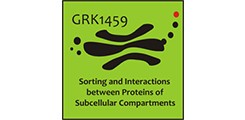
05/2008 - 04/2017
Thomas Braulke (Sprecher + Koordination),
Sandra Pohl & Stephan Storch
Deutsche Forschungsgemeinschaft
Graduiertenkolleg 1459:
"Sortierung und Wechselwirkungen zwischen
Proteinen subzellulärer Kompartimente"
www.grk1459.info09/2014 -08/2016
Thomas Braulke
Fritz Thyssen Foundation
"Molecular mechanisms of increased osteoclastogenesis and immundeficieny in the inherited lysosomal storage disorder mucolipidosis II"
Homepage Fritz Thyssen Foundation: project description (German)
10/2011 - 10/2014
Thomas Braulke
Seventh Framework Programme of European Community (EU-FP7), grant agreement n° 281234
„DEM-CHILD - A Treatment-Oriented Research Project of NCL Disorders as a Major Cause of Dementia in Childhood”
http://www.dem-child.eu/index.php/background-16.html
04/2007 - 09/2013
Thomas Braulke
German Research Foundation (DFG)
Research Unit 885:
"Neuronal Protein Turnover"
http://gepris.dfg.de/gepris/projekt/35615435
07/2010 - 06/2012
Katrin Kollmann
“Skeletal abnormalities in mucolipidosis II alpha/beta
Pathomechanisms and therapeutic strategies”
http://www.mpssociety.org/
Angela Schulz, Stephan Storch and Thomas Braulke
initial financial support for various PhD students
working on NCL diseases
www.ncl-naechstenliebe.de/english/ncl/ -
-
NEWS
2024
3/1/2024 the review on LYSET and its role in lysosomal enzyme trafficking is published in Trends in Cell Biology Abstract
2023
Save the date: FOR2625 Symposium 2024
June 6 - 7, 2024
Max Delbrück Communications Center, Berlin-Buch
The members of the Research Unit FOR2625 "Mechanisms of Lysosomal Homeostasis" invite scientists from all over the world to join our 2nd International FOR2625 Symposium on LYSOSOMES & AUTOPHAGY.
Registration will open in January 2024 und is limited to 160 participants.
For further information please visit www.lysosomes2024.de
2022
9/08/2022 our common paper with the groups of Sabrina Jabs (University Kiel), Dominic Winter (University Bonn) and Jan Carette (Stanford University) reporting the discovery of LYSET controlling the modification of lysosomal enzymes with mannose 6-phosphate residues is officially accepted in Science! Abstract
2021
Save the date: FOR2625 Symposium 2022
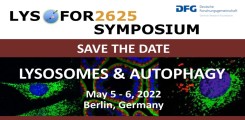
NEW DATE: May 5 - 6, 2022
Max Delbrück Communications Center, Berlin-Buch
Due to the coronavirus outbreak the FOR2625 symposium is postponed from April 2021 to May 2022!
The members of the Research Unit FOR2625 "Mechanisms of Lysosomal Homeostasis" invite scientists from all over the world to join our International FOR2625 Symposium on LYSOSOMES & AUTOPHAGY.
Outstanding scientists have confirmed their participation in our two-day program and will present their newest findings on the molecular machinery of the endo-lysosomal system and autophagy. The symposium offers a great opportunity for young and more advanced researchers to meet internationally renowned experts and discuss their projects during scientific sessions as well as during social events.
Registration will open in November 2021 und is limited to 160 participants.
For further information please visit www.lysosomes2021.de
2020
2nd funding period of Research Unit FOR2625 approved

End of September the German Research Foundation approved the 2nd funding period of the Research Unit FOR 2625 "Mechanisms of Lysosomal Homeostasis" with a funding volume of 3.98 million euro.
The Research Unit was established in October 2017 and consists of eleven German and one Dutch research groups. It aims at elucidating the biogenesis, functions and turnover of lysosomes as a whole, and protein-protein and lipid-protein interactions at the cytosolic surface of lysosomes. Analysing the molecular mechanisms that maintain lysosomal homeostasis will contribute to understand the cause of lysosomal disorders, thereby enabling the development of long-term preclinical therapeutic strategies.
Participating Researchers of the second funding period: Thomas Braulke (Hamburg), Anja Bremm (Frankfurt/Main), Markus Damme (Kiel), Ivan Dikic (Frankfurt/Main), Volker Haucke (Berlin), Christian Hübner (Jena), Thomas Jentsch (Berlin), Judith Klumperman (Utrecht, NL), Tassula Proikas-Cezanne (Tübingen), Paul Saftig (Kiel), Tobias Stauber (Hamburg), Dominic Winter (Bonn)
-
